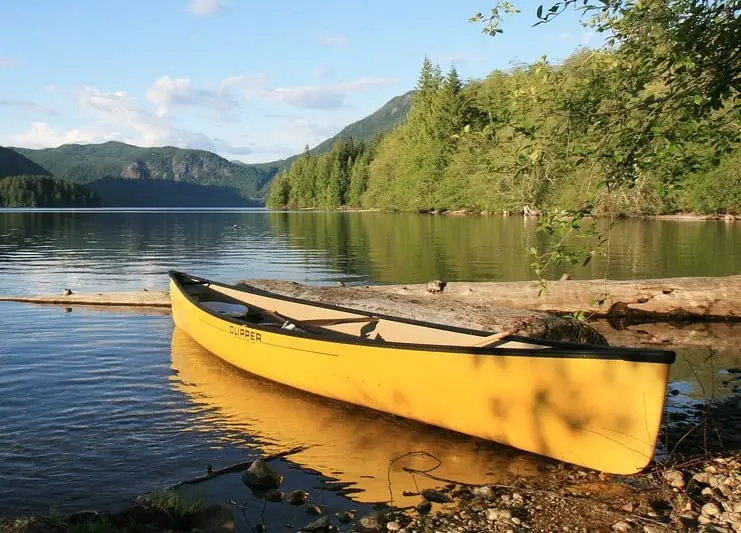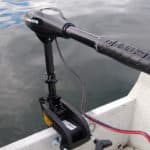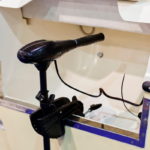Many retailers sell trolling motor mount for canoes, or you can DIY one with a few pieces from your local hardware store and a little work. Most trolling motor mounts are made from a thick piece of aluminum flat bar with two adjustable bolt clamps to secure to the canoe and a block of hardwood for the motor to clamp on.
Most of the available trolling motor mounts are not rated for gas motor because of weight and horsepower, so it is recommended that you use small electric trolling motors for your canoe.
Note: most links in this article are Amazon.com Affiliate links, see Affiliate Disclosure, thank you.
Selecting a trolling motor mount for your canoe
There are two main types of trolling motor mounts for your canoe.
Top rail canoe trolling motor mount
First, the most popular mount is the one I mentioned in the first paragraph, a top rail mount, and is produced by many manufacturers. The basic idea is that a thick piece of flat bar sits on the top rails of your canoe and extends out on one side.
Two blots go through the flat bar with a retainer or clamp system to secure the flat bar to the canoe. A block of hardwood like Ashe is mounted to the piece of flat bar that extends out over the side of the canoe in an upright position so the motor can be mounted to the block.
The advantage to a top rail mount is that they attach to just about any canoe but have limited weight and thrust capacity.
Sidesaddle trolling motor mount
The second type of trolling motor mount is referred to as a side saddle mount. A side saddle mount is shaped like a triangle and clamps to the side of your canoe. The clamp wraps around the top rail of your canoe and needs to be a very specific fit to be secure. Then there is a block that attaches to the top of the mount where the trolling motor is attached.
A side saddle mount is normally manufactured by the manufacturer of your canoe which makes for a perfect fit and a solid connection. Another point is that the clamp doesn’t go across the top of the open area in the canoe blocking any access to any spots of the boat.
The main advantage to a side saddle mount is that it is a stronger connection to your canoe and is rated for heavier and more powerful motors. It is possible to find a gas motor small enough to work safely on this mount providing your canoe has proper buoyancy and balance.

How to make a top rail canoe trolling motor mount
You can head to your local hardware store with this list and build it yourself.
- 4 feet of thick flat bar, or even a hardwood 2 by 4
- 4 feet hardwood 2 by 4 (for the block and brace)
- 4- six inch long ¼ inch carriage bolts
- 2- nylock nuts
- 2- wing nuts
- 4- flat washers
- 2- lock washers
- 1- extra-long ¼ inch drill bit
Step 1:
Cut a block for your motor mount 11 inches long. Clamp it to one end perpendicular to your three foot long flat bar or hardwood 2 by 4. Through the center of the block drill two holes to attach it to the flat bar or 2 by 4. Insert carriage bolts from the top and secure with flat washers and nylock nut.
Step 2:
Lay the piece you just made (mounting bracket) across the top rail of your canoe in the location of your choice, I suggest about two feet from the back of your canoe. Place the leftover 2 by 4 (retainer) and mark it to match the curve of the boat so it will fit snug against the canoe under the rail then cut the line.
Tip: before you cut make sure that none of the canoe framing will interfere with this piece if so move the whole assembly one inch in either direction and remark your retainer.
Step 3:
Put the retainer piece in position under the mounting bracket and drill holes two inches from the top rails to place the bolts in. From the bottom of the retainer insert a carriage bolt through the mounting bracket and secure it with a flat washer, a lock washer, and a wing nut. Repeat with the other hole and your bracket will be ready to use.
Check out this item on Amazon.com
How to make a deck mount trolling motor bracket
If you have a flat edge on your canoe, you can add a deck to your canoe so you can attach a mounting block or a deck mount trolling motor bracket in the same way we secured the last bracket. You can replace the flat bar in our last project (or 2 by 4) with a piece of plywood and trim it to match the width of your canoe. If you place the motor mount on the very back of your canoe, you will need a motor handle extension. The benefit of this design is your motor’s weight, and thrust is down the centerline of your canoe.
Another consideration is that your small electric trolling motor does not need to be mounted perpendicular to your boat. If you build and secure a flat deck, you can place your mounting block in any location the is convenient for you to operate your motor, even the middle of the boat if you so choose. A flat edge canoe is not required to mount a deck in the middle of your canoe and with the battery under the deck could provide better balance.
Square stern canoes
If you have not purchased your canoe and want to use a motor, I would highly recommend a Square stern canoe. A square stern canoe still moves effortlessly through the water in the same way as a traditional canoe but only in one direction similar to the way a traditional boat moves through the water.
The aft of the canoe is a square with a transom for mounting motors. The canoe model I found at Amazon is rated up to 4 horsepower, but I would be using a 55lb electric trolling motor.
Gas trolling motor for square stern canoe
The Old Town Discovery Sport 15 square-stern canoe is rated for a 4 horsepower motor. When I researched gas motors, the smallest motors I found available were 2.5 hp motors. The Mercury/Tohatsu motors are well known for their quality to price balance.
I own a Mercury 8 hp and a Tohatsu 6 hp, that has served me well over the years. At the time of this article, all the small Mercury motors (35 hp and down) are being manufactured by Tohatsu, aka Nissan Marine.
While the price is great, many other motors are being manufactured in Asia for far less, and the few reviews are not bad. I don’t own any of these motors and if I purchase one like the Hangka Sky 3.5 hp I would buy it at Amazon and consider purchasing product protection just for peace of mind.
Electric trolling motor for any type canoe
Honestly, I would never put a gas motor on a canoe. I feel like the peace and quiet of an electric motor is the perfect match for a canoe. Even a square-stern canoe can be moved through the water fast with the smallest electric motor.
With electric motors for canoes and kayaks, there are two schools of thought. First, is that with such a small boat, you should use the smallest motor you can get for several reasons.
You don’t need much thrust to move your canoe because of the size and how easy a canoe moves through the water. If you go with a smaller motor, you will need less power to operate your motor. Also, a smaller motor will weigh less and less weight has many benefits, including buoyancy and power to weight ratio.
The second school of thought is “go big or go home”. I prefer the largest 12-volt motor I can put on a canoe. My two main concerns are buoyancy and trolling speed. Mt thought is that if my boat floats well I am safe, then does it fish well?
Getting your boat to go slow enough to troll while still having enough thrust to have control of your boat is your main goal. If your motor will move you as slowly as 0.8 mph on a still lake, then your motor is not too big. As far as power goes, if you keep your motor on low speed throughout the day battery used should be very low with any size trolling motor.
Lightweight trolling motor batteries
Finding the perfect battery for your canoe can be a challenge, especially if you are concerned about weight. The lightest battery I can recommend is a Mighty Max ML55-12 weighing in at 38.6lbs it can provide a maximum of 55ah. The Mighty Max ML55-12 is also a small deep cycle battery for trolling motor use if space is a concern.
If 39lbs is too much weight for you, then I say break the bank with a lithium battery. The average weight of a lithium battery is around half of any type of acid battery for the same Amp hour rating. Additionally, the amp-hour rating can be used well past the 80% point, which is almost double the average battery.
I say if your boat floats go with the largest battery you can. The VMAX XTR31-135 is a monster battery weighing in at 75lbs. It is a 12-volt AGM battery with 135ah, and I recommend this brand highly.
I own two of the 100ah batteries and when they die If I don’t have the budget for LiPo4 (lithium) I will be buying two of these. I also own two of the seven-stage smart chargers, and they are great for reconditioning batteries saving me a boatload of money, lol.
Trolling motor for your canoe
Cheap Minn Kota trolling motors are the way I would go for my canoe. Newport vessels make some top-rated small trolling motors that can be considered, but Minn Kota is the company to beat with the largest product line and the best customer service.
My first choice of a motor would be the Minn Kota Endura C2 55 lb. thrust with a 36-inch shaft. If price and weight are an issue for you then downsize to the Minn Kota Endura C2 30, for half the cost it is a great value that only weighs 16 lbs.
Drill paddle attachment
I can not skip this little drill attachment, mostly because if I saw you going down the river with this, I would laugh. The attachment is a shaft that attaches to your drill and has a propeller connected to the other end. There is what looks like a foam pad to hold the shaft, but it must have a bearing for the shaft to turn freely.
Do I need to register my canoe if I put a trolling motor on it?
The state marine board in my state says any watercraft with any type of motor must be titled and registered. I am not sure how every state works, but this seems to be a recurring theme. Registering could become a large issue because, in my state, you need a manufacturer’s statement of origin and/or bill of sale to apply for a title and registration.
Conclusion:
Putting a trolling motor on a canoe is very easy to do with a mounting bracket. With the right bracket, you can use a gas motor, but that can be a little loud.
Electric trolling motors will make for a peaceful day on the water. When you choose an electric trolling motor, don’t forget it is a system.
I would always go with an electric motor on any size boat, but with a small boat like a canoe, it is perfect.
Enjoy!
For a general rundown of different types of trolling motor brackets check out our article.
Frequently Asked Questions
Where do you put a trolling motor on a canoe?
On a canoe, there are three places where you can mount a trolling motor. This includes the bow, the transom, and the stern. There are a few factors that are going to determine where the motor is mounted.
First, it depends on how you intend to use the motor and how your canoe is set up because the design can differ slightly between models from different brands. You may also need to invest in a mount if there isn’t one already fitted to your canoe.
Next, you will also need to consider where you will be located when the trolling motor is in use.
Installing a trolling motor isn’t an overly complicated task, however, the method will differ depending on where you intend to mount it. It is worth noting that a trolling motor is going to consume a hefty amount of space when placed on the bow of your canoe.
An engine motor on the other hand is going to be more difficult to control but it isn’t going to take up any room onboard your boat. Due to the size of canoes, the majority of boat owners tend to install a trolling motor to the transom as here they will take up very little space.
How fast will a trolling motor push a canoe?
The majority of electric trolling motors will push a canoe at 4 to 6 mph. It is important to remember that canoes are smaller boats so they will not cope very well with speeds that exceed this. Also, trolling motors are intended for traveling at slower speeds.
When discussing the maximum speed at which you should expect your canoe to travel with a trolling motor, you must consider the power of the battery that it is equipped with. Even canoes with a couple of pounds of thrust are going to reach a maximum of 6mph.
How do you register a canoe with a trolling motor?
In most states, any type of boat or personal watercraft needs to be registered regardless of whether it is powered by gasoline, diesel, or fitted with an electric motor such as a trolling motor. The process of registering your canoe may differ depending on the state.
In some states, you will need to visit the Department of Motor Vehicles or the Department of Licensing. After doing so, you will then receive a license plate that will need to be displayed on the body of your boat.
What size trolling motor do I need for my canoe?
You will need to select a trolling motor that is suitable for the weight of your canoe. Although canoes are lightweight vessels, you must account for the weight that is going to be added to it when you, your gear, and possible passengers are also on board.
In most cases, a 30” electric trolling motor is going to be sufficient for the majority of canoes. If you are going to be mounting it to the engine of your canoe, a motor of this size is going to be correctly submerged in the water.
Trolling motors that are battery-powered tend to come in 3 different voltage variations. This includes 12, 24, and 36 volts. To determine which one is right for your canoe, you must take the size of your vessel into account.
Generally, for canoes and other types of boats that are 16ft and under, a motor that is packed with 12 volts of power is more than likely to suffice. For longer boats, you will likely require a larger trolling motor.



